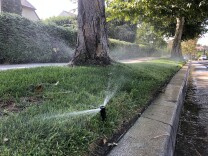
Next Up:
0:00
0:00
-
Listen Listen
Climate & Environment
Some of the country's highest home insurance prices are in the central U.S., a region generally considered to be protected from climate-driven disasters.
Listen
4:32
Sponsor
More Stories
-
Even during epic floods, California is trying to prepare for the next drought by capturing water from this year's big winter storms.
-
Today will stay cloudy and cool, with temperatures below normal in most areas thanks to a marine layer.
-
Southern California growers and water districts agreed to use less water and receive federal funds in return.
-
The brunt of the cuts will be in agriculture. But the agreement is only for the short term.
-
The breakthrough agreement aims to keep the river, which has been shrinking at an alarming rate due to climate change and overuse, from falling to a level that could endanger the water and power supply for major cities in the West and vast stretches of hugely productive farmland.
-
Clouds and marine layer will intensify through Wednesday.
-
Human actions have caused "significant declines" in the amount of water stored in 53% of the planet's largest lakes and reservoirs. Climate change and overconsumption are the primary drivers.
-
Lots of it has to do with our transition from cool to warm weather.
-
A hazard warning has been issued for the Ventura County beaches, Malibu coast, Los Angeles County beaches and Catalina and Santa Barbara Islands due to dangerous rip currents and waves between three and six feet.
-
The research could advance court cases seeking to hold polluters accountable for climate-fueled disasters.
-
The National Weather Service has issued a beach hazards statement for L.A, Ventura and Orange County Beaches that lasts until this evening.
-
An expert used California regulators’ methodology to estimate the cost of cleaning up the state’s onshore oil and gas industry. The study found that cleanup costs will be triple the industry’s projected profits.
Researchers found that in drier years, larger animals are more likely to head closer and closer to where people live.
Listen
4:05
Support your source for local news!
In case you missed it
-
911 recordings obtained by LAist shed light on why and how emergency planning continues to leave people with disabilities behind.
-
LAist investigates illicit dumping at three Antelope Valley sites.
-
An LAist investigation found toxic heavy metals in samples of fire retardant collected from the Palisades, Eaton and Franklin fires. Here's what that means.
More Stories
-
Warehouse workers who work in hot indoor environments say the climate crisis is moving faster than much-needed indoor heat regulation.
-
The last time one of the animals was seen in California was in 2008, and prior to that the most recent sighting occurred in 1922.
-
A new report says a 75% cut in plastics is needed to limit global warming to 1.5 degrees Celsius.
-
A deep marine layer and strong onshore flow mean that clouds will stick around.
-
The state extended a drought regulation banning using drinkable water to irrigate grass at commercial, industrial and institutional properties.
-
Expect patchy fog this morning and clouds throughout the day in the Los Angeles basin, with highs in the mid-60s.
-
To best protect wetlands, permitting and enforcement need to be sorted.
-
A state program is providing needed funding to help the most impacted and underserved communities adapt to climate change. It could serve as a model for new federal climate spending.
-
Most areas will stay in the mid-60s, but the Valleys will see highs in the low 70s.
-
Environmentalists say it’s past time for California water officials to halt Los Angeles’ diversion of Mono Lake’s tributaries. But L.A. officials insist that water is a tiny but vital part of the city’s water supply.




































